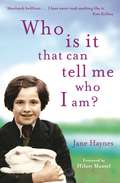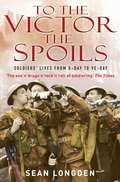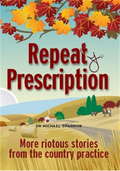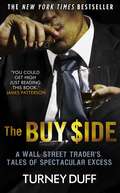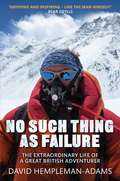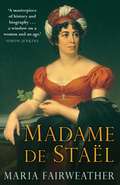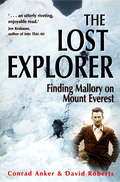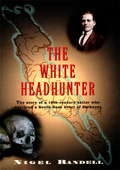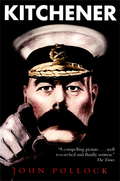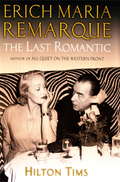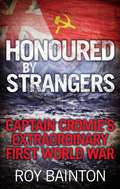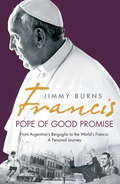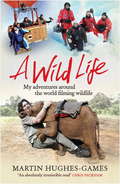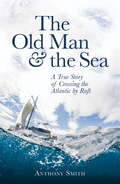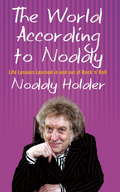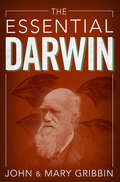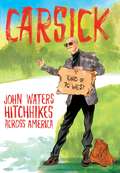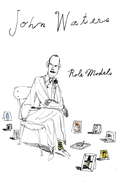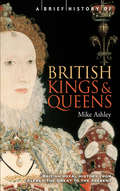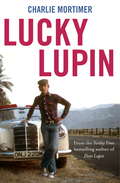- Table View
- List View
Who is it that can tell me who I am?
by Jane HaynesIn this searingly honest memoir, Jane Haynes recalls to her psychotherapist her extraordinary story. Having overcome her strange childhood, overshadowed by her mother's absence and father's descent into madness, the real diagnosis of which the family concealed, she attempts, vividly but without sentimentality, to understand the construction of her own life.Now a psychotherapist in her own right, Haynes opens up her case files, which include a gifted young man on the cusp of a nervous breakdown; the middle-aged woman tormented by suicidal thoughts; the pornography addict, unable to connect emotionally with his girlfriend. Tragedy is brought home to her when her son-in-law is murdered. Her account powerfully demonstrates the resilience and life force of human nature.'I recommend it to anyone concerned with the life of the imagination'Hilary Mantel
To the Victor the Spoils
by Sean LongdenFrom the D-Day landings in June 1944 to the final declaration of peace the following year the Allied forces fought a bitter battle to the end against Hitler's Nazi Germany. Sean Longden re-tells the unexpected true story of life among the ranks of Field Marshall Montgomery's 21st Army group and reveals a tale of sex, burglary, rape, pillage and alcohol. Uncovering new material from interviews, documents and personal accounts, Sean Longden recounts what really happened on the road to Berlin. 'A meticulously-researched, utterly absorbing account of the human story behind the battle to crush Hitler's forces.' Yorkshire Post'From D-Day to VE Day, historian Sean Longden reveals the sex 'n' rock 'n' drugs 'n' rock 'n' roll of soldiering' The Times
Repeat Prescription
by Michael SparrowDr Sparrow is back, coping with more bizarre, macabre and hilarious situations. Following his successful debut with Country Doctor: Hilarious True Stories from a Country Practice, Dr Sparrow once more guides us through the daily rounds of the weird and wonderful in his practice on the Devon/Cornwall border. What would you do if faced with the unsuccessful resuscitation of the wrong patient, being held at gunpoint as a suspected terrorist or confronting a blind man who refuses to stop driving? And what about the little old lady who presents you with a supermarket bag stuffed with £20 notes? Add to this jets crashing on the runway, fleeting glimpses of the Royal Genitalia and the haunting tale of the suicidal stranger and an abducted child - and you will start to have some idea of the unpredictable life of Dr Sparrow.
The Buy Side: A Wall Street Trader's Tale of Spectacular Excess
by Turney DuffThe Buy Side is Turney Duff's high-adrenaline journey through the trading underworld, as well as a searing look at an after-hours Wall Street culture where sex and drugs are the quid pro quo and a billion isn't enough. In the mid-2000's, Turney Duff was, to all appearances, the very picture of American success. One of Wall Street's hottest traders, he was a rising star with Raj Rajaratnam's legendary Galleon Group before forging his own path. What few knew was that the key to Turney's remarkable success wasn't a super-genius IQ or family connections but rather a winning personality - because the real money wasn't made on the trading floor or behind a computer screen, but in whispered deals in the city's most exclusive nightspots, surrounded by the best drugs and hottest women. For Turney, this created a perilously seductive cycle: the harder he partied, the more connected and successful he became, which meant he could party even harder. In time, he became a walking paradox, an addictive mess after hours, and King of the Street from nine to five. Along the way, he learned some important lessons about himself, and the too-wild-to-believe world of Wall Street trading. In The Buy Side, the money is plentiful and the after-hours indulgence even more so, which has proved to be a bestselling and box office winning combination, as the success of The Wolf of Wall Street attests. Fans of Martin Scorsese's film and Michael Lewis's Liar's Poker and The Big Short will want to take a walk on The Buy Side.
No Such Thing As Failure: The Extraordinary Life of a Great British Adventurer
by David Hempleman-AdamsIf there’s an adventure to be had, it’s likely that David Hempleman-Adams has been there first. Ranking alongside Ranulph Fiennes and Chris Bonnington in the pantheon of British explorers, he is the first person in history to achieve what is termed the Adventurers’ Grand Slam, by reaching the Geographic and Magnetic North and South Poles as well as climbing the highest peaks on all seven continents. The question Hempleman-Adams is most often asked is, simply: what drives him on? Why risk frostbite pulling a sledge to the North Pole? Why experience the Death Zone on Everest? Why fly in the tiny basket of a precarious balloon across the Atlantic? Is it simply the case that he likes to push himself to the limits, or is there something more to it? No Such Thing as Failure answers these questions and more, uncovering what drives arguably the world's greatest adventurer.
Madame de Stael
by Maria FairweatherThe influence of the salons of Paris on the thought and culture of the eighteenth century would be difficult to overstate. They were both intellectual powerhouses and also assemblies where the latest and most extreme fashion was displayed.'Young gallants...wearing silk waistcoats embroidered with Chinese pagodas, making love to ladies reclining negligently against the cushions...or accepting small cups of chocolate from the hands of Negro pages', thus Harold Nicolson describes the drawings of the time in his book "The Age of Reason". These meeting places for the vanguard of society were presided over by a succession of brilliantly clever women, the salonieres, and the most brilliant and clever of all of them was Madame de Stael. Although she died at the age of 51 she filled her life to the brim, and enjoyed a hugely influential role among the great names of the day. Born Germaine Necker, in Paris on 22 April 1766, her father was a powerful banker and her mother a Swiss pastor's daughter who never got over her good fortune in marrying a rich man. In 1786 Germaine was married to a secretary in the Swedish embassy called de Stael, but although she thought him 'a perfect gentleman' she also found him dull and clumsy. She began to take lovers - the Vicomte de Narbonne and possibly Talleyrand - and then Benjamin Constant, in whom she at last met her intellectual equal. In 1806 her novel "Delphine" was published. It was an instant success and praised by Goethe and Byron, among others. Her salon thronged with glittering visitors including The Tsar, Talleyrand,and Wellington. Maria Fairweather gives an entrancing account of this vanished world, so merciless to outsiders, but for those of the inner circle incomparably glamorous and exciting.
Madame de Stael
by Maria FairweatherThe influence of the salons of Paris on the thought and culture of the eighteenth century would be difficult to overstate. They were both intellectual powerhouses and also assemblies where the latest and most extreme fashion was displayed.'Young gallants...wearing silk waistcoats embroidered with Chinese pagodas, making love to ladies reclining negligently against the cushions...or accepting small cups of chocolate from the hands of Negro pages', thus Harold Nicolson describes the drawings of the time in his book "The Age of Reason". These meeting places for the vanguard of society were presided over by a succession of brilliantly clever women, the salonieres, and the most brilliant and clever of all of them was Madame de Stael. Although she died at the age of 51 she filled her life to the brim, and enjoyed a hugely influential role among the great names of the day. Born Germaine Necker, in Paris on 22 April 1766, her father was a powerful banker and her mother a Swiss pastor's daughter who never got over her good fortune in marrying a rich man. In 1786 Germaine was married to a secretary in the Swedish embassy called de Stael, but although she thought him 'a perfect gentleman' she also found him dull and clumsy. She began to take lovers - the Vicomte de Narbonne and possibly Talleyrand - and then Benjamin Constant, in whom she at last met her intellectual equal. In 1806 her novel "Delphine" was published. It was an instant success and praised by Goethe and Byron, among others. Her salon thronged with glittering visitors including The Tsar, Talleyrand,and Wellington. Maria Fairweather gives an entrancing account of this vanished world, so merciless to outsiders, but for those of the inner circle incomparably glamorous and exciting.
The Lost Explorer: Finding Mallory on Mount Everest
by Conrad Anker David RobertsIn 1999, Conrad Anker found the body of George Mallory on Mount Everest, casting an entirely new light on the mystery of the lost explorer.On 8 June 1924, George Leigh Mallory and Andrew 'Sandy' Irvine were last seen climbing towards the summit of Everest. The clouds closed around them and they were lost to history, leaving the world to wonder whether or not they actually reached the summit - some 29 years before Edmund Hillary and Tensing Norgay.On 1 May 1999, Conrad Anker, one of the world's foremost mountaineers, made the momentous discovery - Mallory's body, lying frozen into the scree at 27,000 feet on Everest's north face. Recounting this day, the authors go on to assess the clues provided by the body, its position, and the possibility that Mallory had successfully climbed the Second Step, a 90-foot sheer cliff that is the single hardest obstacle on the north face. A remarkable story of a charming and immensely able man, told by an equally talented modern climber.
The White Headhunter
by Nigel RandellShanghaied in San Francisco in 1868, teenage Scots sailor Jack Renton then found himself on a voyage into the heart of darkness. Escaping from his floating prison in an open whaleboat, Renton drifted for 2000 miles, only to be washed up on the shores of a Pacific island shunned by 19th-century mariners, Malaita in the Solomon Islands. There he was stripped of his clothes by headhunters and forced to 'go native' to survive. Initially a slave to their chief, Kabou, he eventually became the man's most trusted warrior and adviser. Renton's own account of his eight-year exile, published after he was rescued, remains the only authenticated account of a mental and physical ordeal that still haunts the imagination to this day. It caused a sensation at the time, though it is now clear that it airbrushed out most of the key events. Researching the Renton legend, Nigel Randell spent several years talking to the Malaitans and piecing together a very different account from Renton's sanitised version. The ultimate irony is that a man so keen to conceal his 'crimes' should have bequeathed their evidence - a necklace of 60 human teeth - to a collector who donated it to a national museum.
Kitchener: The Road to Omdurman and Saviour of the Nation
by John PollockWhen the Great War broke out, Kitchener, with the foresight lacking in many of his contemporaries, insisted that it would last at least three years and that he must raise an army of 3 million men. This began with an immediate recruitment of 100,000 volunteers, and the familiar poster campaign image of him with the line "Your country needs you".Major battles and initiatives of the Great War are recreated in a dramatic narrative history which does justice to Kitchener's masterly planning. This superb double volume biography will transform our view of Kitchener and the First World War.
The Last Romantic: A life of Eric Maria Remarque
by Hilton TimsFew books have made so great an impact, political or literary, as Erich Maria Remarque's All Quiet on the Western Front, the most famous of all anti-war novels. Startling in its realism, intensely moving in its humanity, banned and burned in Germany by the Nazis, it was an international publishing sensation that has never been equalled and has remained a worldwide bestseller for more than seventy years.But who was Remarque While the title of his masterpiece has entered the language as a catchphrase, the name of the author is virtually unknown. In this first British biography, Hilton Tims peels away the veil of anonymity Remarque wove to protect his privacy, to reveal a man whose life was one of the most romantic and anguished of the twentieth century.Remarque was a self made-man - born into a poor family, he moulded himself into a connoisseur of art whose collection became one of the finest in Europe, and an author whose novels brought him wealth, fame and vast readership. He was also the lover of some of the world's most desirable women. At the core of his life was a long-lasting affair with Marlene Dietrich who helped him to flee from the Nazis as Europe went to war. Arch of Triumph, the bestseller he wrote while a stateless émigré in Hollywood, was inspired by the ecstacy and torment Dietrich caused him. Other lovers included Greta Garbo, Dolores del Rio, Maureen O'Sullivan (the 'Jane' of the Tarzan films), the tragic Lupe Velez, the double Oscar winner Luise Rainier, and Paulette Goddard, who became his second wife.Behind the glamour he was a troubled man, haunted by the political fall-out from his famous book, an embittered exile from the Germany he loved, tortured by the infidelities of his first wife, and by the fate of his favourite sister who paid a terrible price in his name at the hands of the Nazis.In Germany, the country that reviled him for most of his life, Remarque is today acclaimed as a literary giant. The rest of the world has forgotten him. Hilton Tims has succeeded in creating a potent and fascinating reminder.
Honoured By Strangers: Captain Cromie's Extraordinary First World War
by Roy BaintonFor many years the story of Cromie has been overshadowed by histories of the greater tragedy found on the Western Front in World War I. Yet, like T E Lawrence, Cromie's individual exploits reveal a classic British hero: noble, tenacious and beloved by all who served under him. Churchill called him a man of exceptional gifts. Cromie became a submarine commander at the remarkably young age of 24. By this time he had already seen action in the Boxer Rebellion, received the China Medal and had been mentioned in despatches. His compassion and care for his men gained him the Royal Humane Society's Bronze Medal, when he almost lost his life attempting to save a drowning sailor. In 1915 he was chosen to head a flotilla of submarines to attack German shipping in the Baltic Sea. Here, he achieved great success despite the hazardous nature of the climate and the threat of the German navy. He was decorated three times by the Czarof Russia and received the DSO. During his three years in the Baltic he became fluent in Russian. He only survived the difficulties of the Bolshevik Revolution in 1917 because of his consummate skills as a mediator and diplomat. His murder in the British Embassy in 1918 at the age of 37 remained a tragic mystery for many years – until now. Bainton's extensive research has revealed why Cromie has previously been omitted from official histories of that difficult period. The circumstances surrounding his murder exposed facts about his complex character, his relationship with the Bolsheviks and the British Establishment - and importantly the story uncovers the duplicity of the allies as they struggled to formulate a reaction to the tidal wave of the Russian Revolution.
Francis: From Argentina's Bergoglio to the World's Francis
by Jimmy BurnsFrom the moment Pope Francis stepped on to the balcony of St Peter's Basilica for the first time, a global audience sensed that not only the Catholic Church but the world at large could be entering a new spiritual, political and social age. In the days following Pope Francis' election, there would be further early signs of the simplicity worthy of the first apostles and the leader that inspired them. Not since John XIII appeared on the scene half a century earlier had a new Pope opened the windows of the Church in such a way as to let in some much needed fresh air. Nevertheless, for the excitement generated by the first Latin American Pope and a man who claimed to want to put the poor back at the centre of the Church's social teaching, people could still only guess where it might be all be leading.Francis: Pope of Good Promise is neither an instant media job, nor a hagiography based on authorised interviews, but the product of diligent investigation across a wide range of official and independent sources - a measured, objective portrait of a man who, in circumstances that he neither sought nor foresaw, found himself handed the highest office at a time of crisis not just for the Church but for long established institutions worldwide from banks to political parties.
A Wild Life: My Adventures Around the World Filming Wildlife
by Martin Hughes-GamesThe frozen wastes of the Southern Ocean; the tropical rainforests of South America, the scorching grasslands of Africa, the dizzy heights of the snow-capped peaks of the Himalayas: Martin Hughes-Games has been to every continent on earth filming natural history programmes. A Wild Life is Martin's personal account of his astonishing adventures around the world, both as a presenter for the BBC and a producer of nature documentaries. We all know Martin as a member of Springwatch and Autumnwatch team, but before his presenting days he spent many years behind the camera producing up-close-and-personal wildlife documentaries on location often in perilous conditions. During a career spanning more than three decades, he has captured the extraordinary life and diversity of the animal kingdom on film - from bloodthirsty bats and man-eating tigers, to huge elephant seals and tiny but ever so painful centipedes.Warmly told with humour and an inimitable style, and packed with insightful facts from the natural world - how fast is the fastest creature on earth, the peregrine falcon? How high can a bird, the bar headed goose on migration, really fly? - A Wild Life has to be one of the natural history books of the year.
A Wild Life: My Adventures Around the World Filming Wildlife
by Martin Hughes-GamesThe frozen wastes of the Southern Ocean; the tropical rainforests of South America, the scorching grasslands of Africa, the dizzy heights of the snow-capped peaks of the Himalayas: Martin Hughes-Games has been to every continent on earth filming natural history programmes. A Wild Life is Martin's personal account of his astonishing adventures around the world, both as a presenter for the BBC and a producer of nature documentaries. We all know Martin as a member of Springwatch and Autumnwatch team, but before his presenting days he spent many years behind the camera producing up-close-and-personal wildlife documentaries on location often in perilous conditions. During a career spanning more than three decades, he has captured the extraordinary life and diversity of the animal kingdom on film - from bloodthirsty bats and man-eating tigers, to huge elephant seals and tiny but ever so painful centipedes.Warmly told with humour and an inimitable style, and packed with insightful facts from the natural world - how fast is the fastest creature on earth, the peregrine falcon? How high can a bird, the bar headed goose on migration, really fly? - A Wild Life has to be one of the natural history books of the year.
The Old Man and the Sea: A True Story of Crossing the Atlantic by Raft
by Anthony SmithOctogenarian Anthony Smith's journey was originally inspired by both the Kontiki Expedition of Thor Heyerdahl (who he knew) and the incredible story of the survivors of a 1940 boat disaster, who spent 70 days adrift in the Atlantic, eventually reaching land emaciated and close to death. While this might sound like a voyage no-one would wish to emulate, to octogenarian Anthony Smith it sounded like an adventure, and he placed a typically straightforward advertisement in the Telegraph that read "Fancy rafting across the Atlantic? Famous traveller requires 3 crew. Must be OAP. Serious adventurers only." In his inimitable style, Smith details their voyage and the hardships they endured with a matter-of-fact air that makes his story seem all the more impressive. His advanced age allows him a wider perspective not only on the journey but on life itself, and his never-say-die attitude to the difficulty of the journey is inspirational. 'Old men ought to be explorers' said T.S. Eliot, and this book certainly gives a compelling argument in his favour. It is both a great story (a huge storm on the final night of the voyage almost wrecked them on a reef) and a call to action for the older generation - do not go quietly, says Anthony Smith, but seek out adventure as long as you are able.
The Old Man and the Sea: A True Story of Crossing the Atlantic by Raft
by Anthony SmithOctogenarian Anthony Smith's journey was originally inspired by both the Kontiki Expedition of Thor Heyerdahl (who he knew) and the incredible story of the survivors of a 1940 boat disaster, who spent 70 days adrift in the Atlantic, eventually reaching land emaciated and close to death. While this might sound like a voyage no-one would wish to emulate, to octogenarian Anthony Smith it sounded like an adventure, and he placed a typically straightforward advertisement in the Telegraph that read "Fancy rafting across the Atlantic? Famous traveller requires 3 crew. Must be OAP. Serious adventurers only." In his inimitable style, Smith details their voyage and the hardships they endured with a matter-of-fact air that makes his story seem all the more impressive. His advanced age allows him a wider perspective not only on the journey but on life itself, and his never-say-die attitude to the difficulty of the journey is inspirational. 'Old men ought to be explorers' said T.S. Eliot, and this book certainly gives a compelling argument in his favour. It is both a great story (a huge storm on the final night of the voyage almost wrecked them on a reef) and a call to action for the older generation - do not go quietly, says Anthony Smith, but seek out adventure as long as you are able.
The World According To Noddy: Life Lessons Learned In and Out of Rock & Roll
by Noddy HolderWhat makes Noddy Holder tick? Godfather of glam, national treasure and thinking grandmother’s crumpet, Noddy has been at the epicentre of British pop culture since he stormed on to the music scene in the 1960s, and in The World According to Noddy he gives us a hilarious window on to his extraordinary life. Told in his own inimitable style, Noddy shares insider accounts of his days on the road, along with a healthy dose of celebrity gossip, and leaves no stone unturned as he expounds on some of his favourite subjects – fame, friendship and fatherhood, the perils of social media and the modern age, not to mention what it would be like if he ruled the world . . . From his early days on the West Midlands beat scene, including a stint as a roadie for Robert Plant, Noddy charts his rise from skinhead stomper to international pop-star, statesman, playboy, male model and philosopher, and of course one of the most integral parts of a Great British Christmas. Witty, wise and tremendously funny, this is Noddy Holder at his glittering best.
The Essential Darwin
by John Gribbin Mary GribbinCharles Darwin was the epitome of the Victorian gentleman amateur scientist, living entirely off inherited wealth and the income from his books. At the same time, however, he was the most professional scientist of his day.Darwin's life is full of contrast. In his youth, he seemed likely to become a wastrel, yet he became a hard-working and renowned scientist. His family life in a small Kentish village was mostly idyllically happy; but the loss of his favourite daughter, Annie, brought him intense misery that lasted long after her death. Darwin shunned publicity; but he became the most famous scientist of his time, for an idea which shook the foundations of Victorian society.Even today, some people reject his idea - evolution by natural selection - without bothering to find out what Darwin said. But it is one of those great achievements of the human intellect with which everyone should be acquainted.
The Essential Darwin
by John Gribbin Mary GribbinCharles Darwin was the epitome of the Victorian gentleman amateur scientist, living entirely off inherited wealth and the income from his books. At the same time, however, he was the most professional scientist of his day.Darwin's life is full of contrast. In his youth, he seemed likely to become a wastrel, yet he became a hard-working and renowned scientist. His family life in a small Kentish village was mostly idyllically happy; but the loss of his favourite daughter, Annie, brought him intense misery that lasted long after her death. Darwin shunned publicity; but he became the most famous scientist of his time, for an idea which shook the foundations of Victorian society.Even today, some people reject his idea - evolution by natural selection - without bothering to find out what Darwin said. But it is one of those great achievements of the human intellect with which everyone should be acquainted.
Carsick: John Waters Hitchhikes Across America
by John WatersFrom the Pope of Trash himself, John Waters, Carsick is his hilarious (if not always 100% true) account of hitchhiking fearlessly into the heart of middle America.John Waters is putting his life on the line. Armed with wit, a pencil-thin moustache, and a cardboard sign that reads 'I'm Not Psycho', he hitchhikes across America from Baltimore to San Francisco, braving lonely roads and treacherous drivers. But who should we be more worried about, the delicate film director with genteel manners or the unsuspecting travelers transporting the Pope of Trash?Along the way, Waters fantasizes about the best and worst possible scenarios: a friendly drug dealer hands over piles of cash to finance films with no questions asked, a demolition-derby driver makes a filthy sexual request in the middle of a race, a gun-toting drunk terrorizes and holds him hostage, and a Kansas vice squad entraps and throws him in jail. So what really happens when this cult legend sticks out his thumb and faces the open road? Laced with subversive humour and warm intelligence, Carsick is an unforgettable ride with a wickedly funny companion - and a celebration of America's weird, astonishing, and generous citizens.
Role Models
by John WatersRole Models is a wild and witty self-portrait of John Waters, America's 'Pope of Trash', told through intimate profiles of his favourite personalities - some famous, some unknown, some criminal, some surprisingly middle of the road. From Esther Martin, owner of the scariest bar in Baltimore, to the playwright Tennessee Williams; from the atheist leader Madalyn Murray O'Hair to the insane martyr Saint Catherine of Siena; from the English novelist Denton Welch to the timelessly appealing singer Johnny Mathis - these are the extreme figures who helped John Waters form his own brand of neurotic happiness.A paean to the power of subversive inspiration that delights, amuses and happily horrifies in equal measure...
A Brief History of British Kings & Queens (Brief History)
by Mike AshleyHere is the whole of recorded British royal history, from the legendary King Alfred the Great onwards, including the monarchies of England, Scotland, Wales and the United Kingdom for over a thousand years. <P><P>Fascinating portraits are expertly woven into a history of division and eventual union of the British Isles - even royals we think most familiar are revealed in a new and sometimes surprising light. This revised and shortened edition of The Mammoth Book of British Kings & Queens includes biographies of the royals of recorded British history, plus an overview of the semi-legendary figures of pre-history and the Dark Ages - an accessible source for students and general readers.
Lucky Lupin
by Charlie MortimerLucky Lupin is a poignant yet light-hearted story of survival against the odds, based on Charlie Mortimer's life with HIV/Aids during the early years (1984-1996), when there was neither treatment nor cure. Using a combination of good luck, gallows humour, Fray Bentos pies and copious quantities of Solpadeine, Charlie survived not only the illness but the hysteria that accompanied the so-called 'gay plague'. Anyone infected became a social pariah; had the local launderette got word of his illness they wouldn't have washed his sheets but burnt them. Whilst taking full responsibility for the consequences of his behaviour - 'The fact is you don't get AIDS from watching telly' - Charlie initially took to the sofa and prepared for death, but, in time, he found the inner strength required to confront his fatal diagnosis, becoming, among other things, an antiques dealer and contemporary art collector.With blistering and often hilarious candour Charlie also recounts his childhood where he developed a passion for cars, cultivated by his adventurous mother 'Nidnod', his dizzying array of careers and somewhat curious domestic arrangements including the 'adoption' of a bank robber for twelve years. He also confronts head on his experiences of coming to terms with confused sexuality, addiction, epilepsy and clinical depression before finding lasting contentment.Praise for Dear Lupin:'As well as being the funniest book I've read in ages, it's also extremely touching. A delight then, on every front.' The Spectator 'Very, very funny.' Sunday Times'Wry, trenchant, often extremely funny, but also charmingly forbearing and forgiving.' Country Life
Lucky Lupin: A Memoir
by Charlie MortimerLucky Lupin is a poignant yet light-hearted story of survival against the odds, based on Charlie Mortimer's life with HIV/Aids during the early years (1984-1996), when there was neither treatment nor cure. Using a combination of good luck, gallows humour, Fray Bentos pies and copious quantities of Solpadeine, Charlie survived not only the illness but the hysteria that accompanied the so-called 'gay plague'. Anyone infected became a social pariah; had the local launderette got word of his illness they wouldn't have washed his sheets but burnt them. Whilst taking full responsibility for the consequences of his behaviour - 'The fact is you don't get AIDS from watching telly' - Charlie initially took to the sofa and prepared for death, but, in time, he found the inner strength required to confront his fatal diagnosis, becoming, among other things, an antiques dealer and contemporary art collector.With blistering and often hilarious candour Charlie also recounts his childhood where he developed a passion for cars, cultivated by his adventurous mother 'Nidnod', his dizzying array of careers and somewhat curious domestic arrangements including the 'adoption' of a bank robber for twelve years. He also confronts head on his experiences of coming to terms with confused sexuality, addiction, epilepsy and clinical depression before finding lasting contentment.Praise for Dear Lupin:'As well as being the funniest book I've read in ages, it's also extremely touching. A delight then, on every front.' The Spectator 'Very, very funny.' Sunday Times'Wry, trenchant, often extremely funny, but also charmingly forbearing and forgiving.' Country Life
